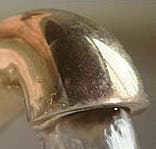EPA has posted information about the 90th percentile levels for lead in drinking water for 85 percent of the nation’s 838 water systems serving more than 50,000 people.
The data received to date show that 22 systems exceeded the 15 parts per billion (ppb) action level for lead in one or more monitoring periods since 2000. Only eight systems exceeded the action level in 2003.
If tap monitoring samples from more than 10 percent of the homes served by a system exceed the15 ppb action level as determined by the concentration at the 90th percentile, the utility must undertake a number of actions. These actions include addressing the corrosion control treatment process, increase monitoring, carrying out public education efforts and potentially, replacing lead service lines.
A national review is underway of the implementation and compliance with the national primary drinking water regulation for lead in response to the elevated drinking water lead levels in Washington, D.C. As part of its review, EPA is working to determine whether the problems Washington, D.C. is experiencing reflect a nationwide problem.
States are required to submit information to EPA related to 90th percentile levels after water utilities conduct required monitoring for lead in drinking water.
There are approximately 53,000 community water systems in the United States. EPA is continuing to work to collect lead 90th percentile information for systems in other size categories and will report on its findings throughout the summer.
A summary of the findings for large systems and related data is available at www.epa.gov/safewater/lcrmr/implement.html. General information about lead in drinking water and the Washington, D.C. problem can be found at www.epa.gov/safewater/lead.
Source: EPA


